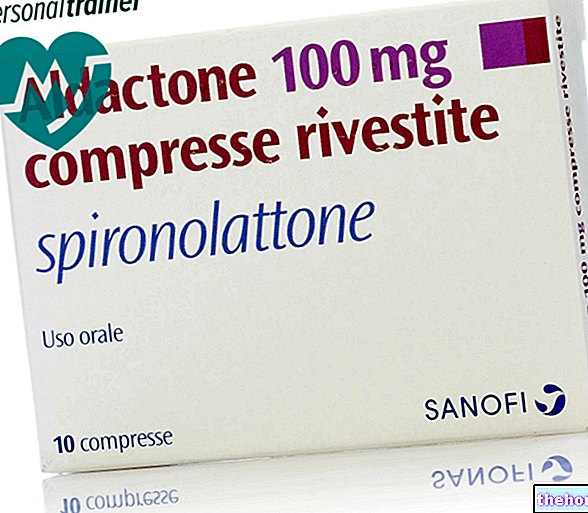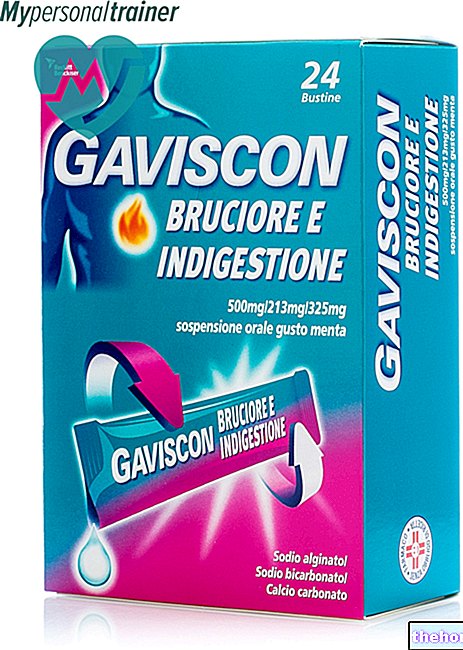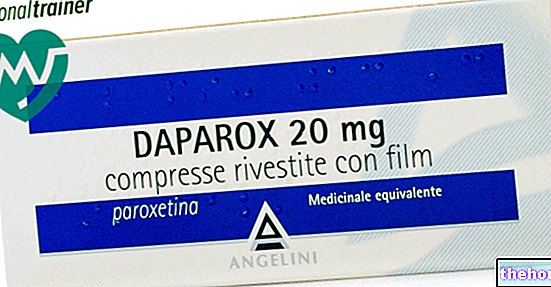Active ingredients: Potassium canrenoate, Butizide
Kadiur 50 mg + 5 mg film-coated tablets
Why is Kadiur used? What is it for?
Kadiur contains the combination of the two active substances potassium canrenoate and butizide, substances with diuretic action, that is, they favor the production of urine without reducing the levels of potassium in the blood.
Kadiur is used in case of swelling due to fluid build-up (edema) caused by an increase in the production of a hormone called aldosterone, which regulates the levels of sodium, potassium and the volume of fluids in the body.
Kadiur is used for example in case of swelling due to:
- liver disease (liver cirrhosis in ascitic phase)
- reduced heart function (congestive heart failure)
- kidney disease (nephrotic edema)
Contraindications When Kadiur should not be used
Do not take Kadiur:
- if you are allergic to potassium canrenoate, butizide or any of the other ingredients of this medicine;
- if you are allergic to other medicines of the same type (sulphonamides);
- if you have acute or chronic kidney problems
- if you have severe liver problems
- if you have high levels of potassium in your blood
- if you have low levels of sodium in the blood.
Precautions for use What you need to know before taking Kadiur
Talk to your doctor or pharmacist before taking Kadiur.
Contact your doctor if the following symptoms occur during treatment with Kadiur:
- dry mouth,
- thirst,
- muscle weakness,
- drowsiness,
- agitation,
- muscle cramps,
- low blood pressure,
- decrease in the amount of urine,
- increased heart rate
- stomach and intestinal disorders.
Your doctor may have your blood and urine tests done periodically to check the salt levels in your blood.
If you are taking medicines called glucocorticoids or are being treated with ACTH, or if you have severe liver cirrhosis, your doctor will prescribe a potassium supplement and recommend a high potassium diet.
If you have an autoimmune disease called 'lupus erythematosus', taking Kadiur can increase the symptoms.
If you suffer from diabetes, following treatment with Kadiur, you may experience an increase in the levels of uric acid in the blood and an increase in the levels of glucose in the blood, as a result you may have temporary changes in your state of health.
If you need to have local or general anesthesia, tell your doctor that you are taking Kadiur.
If you have had an operation called sympathectomy, Kadiur can cause a sharp decrease in blood pressure.
For those who carry out sporting activities: the use of the drug without therapeutic necessity constitutes doping and can in any case determine positive anti-doping tests.
Interactions Which drugs or foods can change the effect of Kadiur
Tell your doctor or pharmacist if you are taking, have recently taken or might take any other medicines.
It is especially important that your doctor know if you are taking any of the following medicines:
- medicines used to thin the blood (oral anticoagulants), as their action may be reduced by taking Kadiur at the same time
- tubocurarine (used for anesthesia), as Kadiur can increase its effect
- aspirin (acetylsalicylic acid) and / or derivatives, as they reduce the activity of Kadiur.
Kadiur can interfere with some laboratory tests to measure calcium and phosphorus in the blood.
Warnings It is important to know that:
Pregnancy and breastfeeding
If you are pregnant or breast-feeding, think you may be pregnant or are planning to have a baby, ask your doctor or pharmacist for advice before taking this medicine.
Pregnancy
Kadiur should be used during pregnancy only when clearly needed and under the direct supervision of your doctor, who will assess whether the benefits for you outweigh the risks for the fetus.
Feeding time
Kadiur should not be used while breastfeeding.
Driving and using machines
In rare cases, treatment with Kadiur can affect reflexes and decrease the ability to drive cars. Drinking alcohol may increase this effect. Take these effects into account if you have to drive or operate machinery that requires a certain level of alertness.
Kadiur contains lactose and castor oil
Kadiur contains lactose. If you have been told by your doctor that you have an intolerance to some sugars, contact your doctor before taking this medicinal product. Kadiur contains castor oil. It can cause stomach upset and diarrhea.
Dosage and method of use How to use Kadiur: Dosage
Always take this medicine exactly as your doctor or pharmacist has told you. If in doubt, consult your doctor or pharmacist.
The recommended dose is:
Adults
1-2 tablets per day.
If you forget to take Kadiur
Do not take a double dose to make up for a forgotten tablet.
If you stop taking Kadiur
If you have any further questions on the use of this medicine, ask your doctor or pharmacist.
Overdose What to do if you have taken too much Kadiur
Rarely during therapy with Kadiur there may be a decrease in salts in the body.
In case of accidental ingestion of an overdose of Kadiur, notify your doctor immediately or go to the nearest hospital.
Side Effects What are the side effects of Kadiur
Like all medicines, this medicine can cause side effects, although not everybody gets them.
Many of the side effects listed below are temporary and / or improve with a reduction in dosage.
In the presence of severe manifestations, please contact your doctor, who will decide to reduce the dosage or discontinue treatment.
Uncommon side effects (may affect up to 1 in 100 people):
- Increased levels of uric acid in the blood
- Increase in blood glucose values
- Dizziness
- Altered color vision (xanthopsia)
- Rapid decrease in blood pressure following a transition from lying or sitting to standing (orthostatic hypotension)
- Acute or chronic inflammatory lesion of a blood or lymphatic vessel (angioitic processes)
- Appearance of spots or redness on the skin following exposure to direct sunlight, including the solarium. Sudden and involuntary contractions of the muscles
- Muscle weakness.
Rare side effects (may affect up to 1 in 1000 people):
- Drowsiness
- Decreased alertness (numbness)
- Headache
- Fever
- Tendency to lose muscle coordination
- Upset stomach and intestines
- Appearance of spots and / or reliefs on the skin
- Breast enlargement in men
- Disorders of erection
- Slight masculinizing effects.
Reporting of side effects
If you get any side effects, talk to your doctor or pharmacist. This includes any possible side effects not listed in this leaflet. You can also report side effects directly via the national reporting system at www.agenziafarmaco.it/it/responsabili. By reporting side effects you can help provide more information on the safety of this medicine.
Expiry and Retention
This medicine does not require any special storage conditions.
Keep this medicine out of the sight and reach of children.
Do not use this medicine after the expiry date which is stated on the carton after "EXP". The expiry date refers to the last day of that month.
Do not throw any medicines via wastewater or household waste. Ask your pharmacist how to throw away medicines you no longer use. This will help protect the environment.
Other information
What Kadiur contains
- The active ingredients are: potassium canrenoate and butizide. One coated tablet contains 50 mg of potassium canrenoate and 5 mg of butizide.
- The other ingredients are: anhydrous colloidal silica, hydrogenated castor oil, sodium bicarbonate, amberlite (potassium salt of the methacrylic acid-divinylbenzene copolymer), magnesium stearate, microgranular cellulose, lactose, titanium dioxide, propylene glycol, hypromellose.
Description of what Kadiur looks like and contents of the pack
Kadiur comes in the form of 50 mg + 5 mg film-coated tablets in cartons of 20 tablets and cartons of 30 tablets.
Source Package Leaflet: AIFA (Italian Medicines Agency). Content published in January 2016. The information present may not be up-to-date.
To have access to the most up-to-date version, it is advisable to access the AIFA (Italian Medicines Agency) website. Disclaimer and useful information.
01.0 NAME OF THE MEDICINAL PRODUCT
KADIUR
02.0 QUALITATIVE AND QUANTITATIVE COMPOSITION
KADIUR® 50 mg + 5 mg film-coated tablets: Each tablet contains: active ingredients: potassium canrenoate 50 mg, butizide 5 mg.
KADIUR® 200 mg + 6 mg powder and solvent for solution for injection: Each bottle of lyophilisate contains: active ingredients: potassium canrenoate 200 mg, butizide 6 mg.
For excipients, see section 6.1.
03.0 PHARMACEUTICAL FORM
Film-coated tablets
Powder and solvent for solution for injection
04.0 CLINICAL INFORMATION
04.1 Therapeutic indications
Pathological states characterized by a secondary increase in aldosterone (edema and ascites from liver cirrhosis and congestive heart failure, nephrotic edema).
04.2 Posology and method of administration
Hydrosodioritentive states: attack therapy: 1-4 bottles / day by slow i.v. (at least 2-3 minutes first); maintenance therapy: 1 - 2 tablets / day.
04.3 Contraindications
Acute and chronic renal failure, severe hepatic insufficiency, hyperkalaemia, hyponatremia, ascertained individual hypersensitivity to the components and / or to other sulfonamide derivatives.
04.4 Special warnings and appropriate precautions for use
During therapy with KADIUR® it is generally unnecessary to provide an additional supply of potassium. In fact, the greatest advantage of KADIUR® is represented by the potassium retentive action expiliated by the spironolactone fraction. A potassium supplement may be prescribed only in case of simultaneous therapy with glucocorticoids, giving preference to a diet with a high potassium content. For the thiazide component , in patients with lupus erythematosus, the administration of KADIUR® can accentuate the systemic symptoms. Periodic checks of blood and urinary electrolytes are recommended in cases with profuse emesis and in subjects undergoing parenteral fluid therapy. It should be borne in mind that preparations such as digitalis can also influence the serum ionogram and enhance the metabolic effects of hypokalaemia, especially as regards myocardial activity. The first pathognomonic symptoms of any disturbances in the hydroelectrolytic turnover are: dry mouth, thirst, asthenia, drowsiness, agitation, muscle cramps, hypotension, oliguria, tachycardia and gastrointestinal disorders. In patients with impaired hepatic function, the administration of the thiazide diuretic alone, resulting in potassium depletion, could trigger the rapid evolution towards hepatic coma. In this sense, KADIUR® is configured as a more complete and safe drug as the spironolactone component minimizes the kaliuretic effects of the thiazide. Some patients with refractory edema may experience azotemic and / or ammonia elevations presumably related to changes in glomerular filtrate (prerenal azotemia) rather than to nephrotoxicity. These manifestations regress, however, spontaneously following the temporary suspension of therapy. The most frequent dysionia observed during therapy with KADIUR® is represented by dilution hyponatremia; this can be corrected by restricting the intake of fluids, with corticosteroid therapy, or by using osmotic diuretics (mannitol, urea) except than in uremic subjects or in those with severe renal insufficiency. The hypotensive effects of butizide can be enhanced in sympathectomized subjects. Thiazide diuretics can interfere with some laboratory tests for the functional evaluation of parathyroid glands, with hypercalcemia and hypophosphataemia .
Thiazides can cause a reduction in serum iodine bound to proteins without however indicating dystyroidism. To be used under direct medical supervision.
Keep out of reach of children.
04.5 Interactions with other medicinal products and other forms of interaction
During regional or general anesthesia it must be taken into account that butizide and derivatives and spironolactones depress the sensitivity of the vessels to catecholamines. Thiazides can also enhance the response to tubocurarine and antagonize the effect of oral anticoagulants. The simultaneous administration of acetylsalicylic acid and / or derivatives reduces the diuretic activity of the product.
04.6 Pregnancy and breastfeeding
Thiazides cross the placental barrier, therefore it is recommended that the use of the product during pregnancy is done only in case of real need under the direct supervision of the doctor, carefully evaluating the potential benefits in relation to the possible risks for the mother and the fetus.
The product should not be used during breastfeeding.
04.7 Effects on ability to drive and use machines
Treatment can in rare cases affect reflexes by decreasing eg. reactive ability in driving cars. Drinking alcohol can potentiate this effect.
04.8 Undesirable effects
Somnolence, drowsiness, gastrointestinal disorders, gynecomastia, erection disturbances, mild androgenic effects, headache, skin rashes, temperature rises and ataxia have rarely been reported. Sometimes dizziness, xanthopsia, photosensitization, angioitic processes, orthostatic hypotension, muscle spasms, asthenic states can occur. Thiazides can induce secondary hyperuricemia and decreased glucose tolerance by transiently enhancing metabolic disturbances in diabetic patients. In the presence of marked or severe manifestations, it is recommended to reduce the dosage or to discontinue treatment.
04.9 Overdose
Rarely during therapy with KADIUR® a full-blown hyposaline syndrome may develop, which differs from dilution hyponatremia in that it is not accompanied by water retention. The correction of this state is based on the temporary suspension of diuretic therapy and the administration of sodium salts.
Although rarely, hyperkalaemia may also occur due to the presence of potassium canrenoate; however, this occurs only in subjects subjected to a diet that is particularly rich in potassium, or in those with a high concentration of diuresis (less than 1000 ml / 24 hours). In such patients, serum ionograms should be determined serially.
Only rarely has severe hyperkalaemia been described.
Any hyperkalemic states can be readily counteracted by rapid infusion of hypertonic glucose solutions (20-50%) and ready-made insulin (0.25-0.5 units per gram of glucose) and possibly resorting to ion exchange resins via the evo course. you will also have to stop the administration of KADIUR® and avoid potassium salt supplements.
05.0 PHARMACOLOGICAL PROPERTIES
05.1 Pharmacodynamic properties
KADIUR® is an "association of two diuretics with different mechanisms of action", an antialdosteronic (potassium canrenoate) and a thiazide (butizide). The two active principles possess a "complementary action: potassium canrenoate acts by opposing the reabsorption of sodium and water at the level of the distal segment of the renal tubule, while butizide exerts this effect at the level of the proximal segment. Furthermore, the potassium-sparing effect performed. from antialdosteronics reduces the risk of hypokalaemia to a minimum, even during protracted treatments. For these complementary actions, KADIUR® exerts a marked diuretic action even in patients refractory to other treatments. Unlike spironolactone, the progenitor of antialdosteronic diuretics, potassium canrenoate is water-soluble. Like other substances that interfere with hormonal activities, spironolactone (and therefore probably also its derivatives), administered at much higher doses than therapeutic ones and for very prolonged times, can sometimes lead to an increase in the incidence of some types of processes in the rat. heteroplastic. In the current state of scientific knowledge it is not possible to attribute to these observations any certain significance for man.
05.2 Pharmacokinetic properties
Potassium canrenoate is optimally absorbed orally and, after its administration, very high plasma levels of canrenone, the active metabolite, are found.
In fact, this shows in man an elevated blood peak at the third-fourth hour, with levels still very high at the twelfth hour and a half-life of several hours. The main elimination routes are renal and biliary ones. Butizide, as in general all the thiazides, is also optimally and rapidly absorbed from the gastrointestinal tract, with evident diuretic effects within 4-8 hours. The drug is excreted by the kidney and has a half-life of several hours.
05.3 Preclinical safety data
From the toxicological point of view it has been demonstrated that the product has a low acute toxicity (LD50 = 105.9 mg / kg by the iv route and 1499 mg / kg by mouth in the mouse; LD50 = 105.7 mg / kg by the iv route 1730 mg / kg per os in rat) and chronic (rat os for 12 months, dog iv for 3 months and dog os for 12 months) and is devoid of teratogenic effect (rat and rabbit os), peri- and post- natal (rat os and subcutaneous) and mutagenic activity (DNA damage and repair, gene mutation, Ames test).
06.0 PHARMACEUTICAL INFORMATION
06.1 Excipients
Film-coated tablets: precipitated silica, hydrogenated castor oil, sodium bicarbonate, amberlite (potassium salt of the methacrylic acid-divinylbenzene copolymer), magnesium stearate; microgranular cellulose, lactose. Film coating: titanium dioxide, propylene glycol, hypromellose.
Powder and solvent for solution for injection: each solvent bottle contains: water for injections.
06.2 Incompatibility
There are no known chemical or physico-chemical incompatibilities.
06.3 Period of validity
In intact packaging: 3 years.
06.4 Special precautions for storage
This medicinal product does not require any special storage conditions.
06.5 Nature of the immediate packaging and contents of the package
Film-coated tablets: carton containing aluminum / aluminum blisters. Box of 20 tablets
Film-coated tablets: carton containing aluminum / aluminum blisters. Box of 30 tablets
Powder and solvent for solution for injection: box containing 6 bottles of lyophilisate + 6 bottles of solvent
06.6 Instructions for use and handling
No special instructions.
07.0 MARKETING AUTHORIZATION HOLDER
Therabel GiEnne Pharma S.p.A. - Via Lorenteggio, 270 / A - 20152 Milan
08.0 MARKETING AUTHORIZATION NUMBER
Film-coated tablets - 20 tablets: AIC 025166024
Film-coated tablets - 30 tablets: AIC 025166036
Powder and solvent for solution for injection - 6 lyophilisate bottles + 6 solvent bottles: AIC 025166048
09.0 DATE OF FIRST AUTHORIZATION OR RENEWAL OF THE AUTHORIZATION
28/12/1983 - Renewal: June 2005
10.0 DATE OF REVISION OF THE TEXT
01/11/2005




























